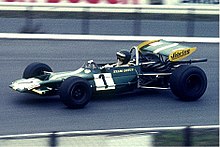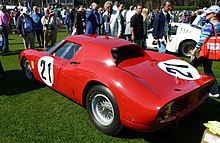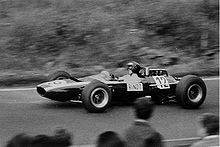Jochen Rindt
In practice for the Italian Grand Prix at Monza, he spun into the guardrails after a failure on his car's brake shaft, and a poorly installed crash barrier gave way.
As his closest competitor Jacky Ickx was unable to score sufficient points in the remaining races of the season, Rindt was awarded the World Championship posthumously.
[7] His interest in motorsport greatly increased when he visited the 1961 German Grand Prix at the Nürburgring with school friends, including fellow future Formula One driver Helmut Marko.
[3][8] In 1963, Rindt switched to Formula Junior with the assistance of Kurt Bardi-Barry, a wealthy owner of a travel agency and one of Austria's leading drivers at the time; Barry gave him his one-year-old Cooper T67[8] and the two men formed a partnership, driving to races together.
[18] At the start, the drivers had to run to their cars; Rindt entered with a forward roll that allowed him to get his foot on the throttle instantly and take an early lead.
[20] After thirty minutes of repairs, the car restarted and Rindt and Gregory agreed to drive the rest of the event "flat out", at full speed and with the accompanying risk.
At the season opener in South Africa on New Year's Day, Rindt placed third, being elevated by a late retirement from Jackie Stewart and closing on second-placed Graham Hill towards the end.
Rindt felt uncomfortable with the move, owing to the notorious unreliability of the Lotus car; in a twenty-month period between 1967 and 1969, the team was involved in 31 accidents.
[3] At the end of the year, Motor Sport magazine called him "[t]he only driver to challenge Stewart seriously throughout the season", albeit placing only fourth in the championship.
[45] At the British Grand Prix, Rindt fought a close battle with Stewart for the lead; both men were 90 seconds ahead of third-placed Jacky Ickx.
The race was decided in Stewart's favour only when Rindt had to enter the pits after part of his car's bodywork started to rub on the tyre; he finished fourth.
[3] His victory was overshadowed by a serious accident involving his teammate Hill, who crashed after a high speed puncture and suffered major leg injuries.
[48] For 1970, Rindt's partner at Lotus was John Miles; Graham Hill had left the team to drive for Rob Walker's customer franchise.
[49] At the first Grand Prix of the season in South Africa, he qualified fourth, but eventually retired with an engine failure after a first lap incident with Chris Amon and Jack Brabham, the latter of whom went on to win for the final time in his career.
Further innovations included torsion bar suspension in place of the widely used coil-springs, and all four brakes mounted inboard to reduce unsprung weight.
Rindt used the Lotus 49 one last time at the Belgian Grand Prix, a race at which he heavily criticised the organisers for installing guardrails that had gaps of several metres between them.
[53] Rindt went on to take his maiden victory in the Lotus 72, but it was not a joyful occasion for him; on lap 23, his close friend Piers Courage, with whom he had eaten dinner just the night before, died in a fiery crash.
During practice for the French Grand Prix, Rindt opted to drop his new all-enveloping Bell-Star crash helmet, finding it too hot.
His victory was cast into doubt shortly after the race when Chief Scrutineer Cecil Mitchell found the rear aerofoil not at the regulated height.
The Grand Prix Drivers' Association (GPDA), represented by Rindt and Graham Hill, demanded changes to the circuit to increase safety, including Armco barriers along the entire 22.8 kilometres (14.2 mi) of the Nordschleife.
[3] The paddock moved to the Italian Grand Prix at Monza, a track known for high speeds; drivers often used the slipstream of cars in front to increase their pace.
Rindt's teammate John Miles was unhappy with the wingless setup in Friday practice, reporting that the car "wouldn't run straight".
Rindt was in the habit of using only four points on the five-point harness then available and did not wear the crotch straps, as he wanted to be able to exit the car quickly in the event of fire.
[4][60][61] Later investigations found that the accident was initiated by a failure of the car's right front inboard brake shaft, but that Rindt's death was caused by poorly installed crash barriers.
[69] The championship trophy was handed to his widow Nina by Jackie Stewart on 18 November 1970 in a ceremony near the Place de la Concorde in Paris.
In 2000, on the 30th anniversary of his death, the city of Graz unveiled a bronze plaque in remembrance of Rindt, with wife Nina and daughter Natasha present.
[3] After Rindt's death, his wife Nina stayed close with the Stewarts and can be seen visiting them at the 1971 Monaco Grand Prix in the Roman Polanski-produced film Weekend of a Champion.
[76] He sparked public criticism in 1968 when he flipped over a Mini Cooper during a demonstration run at an autocross event in Großhöflein, while his pregnant wife was on board.
Using his connections, he brought in his friend Joakim Bonnier and former Mercedes Grand Prix manager Alfred Neubauer as opening speakers, with other drivers such as Jackie Stewart attending.
The monthly programme included tips for driving on public roads, reports from Grands Prix and interviews of fellow drivers by Rindt.









